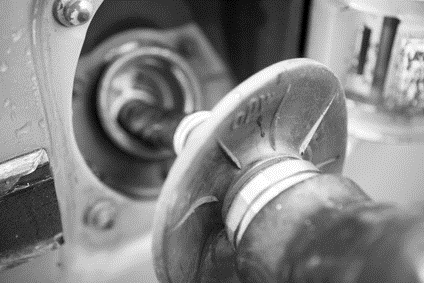
Most of the fuel pumps used on present-day vehicles are electric and located in the fuel tank. Some vehicles use two fuel pumps: one in the fuel tank and one on the driver's side forward lower frame rail. The in-tank pump sends the fuel under low pressure to the pump located on the frame rail. The fuel pump on the rail increases the fuel pressure to the required pressure needed by the fuel injectors.
Until the mid 1970s, vehicles used a carburetor and had a mechanical fuel pump. The mechanical fuel pump was located on the engine. A mechanical fuel pump is driven by a concentric on the camshaft sprocket. The concentric operates a push rod that goes up and down. In turn, the push rod pushes the arm of the fuel pump causing the operation of the fuel pump.
With the introduction of the fuel-injected engine, far more fuel pressure was necessary and at a steadier volume. The mechanical pumps supplied from 4 to 8 pounds of pressure, while the electric pumps supply from 20 to 70 pounds of pressure, with 45 pounds as the median.
A rudimentary understanding of the fuel delivery system used in today's vehicles, as well as the impact the fuel pumps and system components have on the entire system operation, is necessary to predict and prevent failures. While not all failures can be prevented, they can be delayed with proper care of the fuel-pump system.
The function of the fuel pump is to supply the necessary pressure to the fuel injectors at all times. The fuel pressure must be constant, as well as the volume. When the ignition key is turned on, the computer energizes the fuel pump for two seconds, and if the computer does not sense the engine being started it shuts off the power to the fuel pump. The computer will only allow the fuel pump to continue to operate as long as the engine is running. This is a safety function in the event of an accident. It is important to fuel-pump operation to understand a little basic information on fuel injectors. Fuel injectors are operated by the use of an electromagnet inside the injector. The orifice that supplies the fuel is the size of a hypodermic needle. In most cases there are three to five small holes in the tip of the injector. Injectors do not open farther to increase the amount of fuel supplied, just longer. The length of time the injector is opened is determined by the computer through sensory inputs as to demand. For this reason, a small change in fuel-pump operation relative to pressure of volume (in which it is possible to have one without the other) will cause major engine-performance changes.
The first type is the mechanical pump, located on the engine block. It is very reliable and produces 4 to 8 pounds of pressure.
The second type--the in-tank electrical fuel pump--is the most commonly used. The size of this pump depends on the demand, which is relative to engine size and manufacturer. The fuel pressure for these pumps is from 20 to 70 pounds.
The third type is the twin pump system used mostly in situations where the fuel tank is too far from the engine to keep a steady pressure; for example, a long truck. There is one fuel pump in the tank, or one in each fuel tank, and this is called a supply pump. This pump is usually a lower-pressure pump of 20 to 30 pounds. It supplies fuel to a second fuel pump that is close to the engine and the second pump builds the fuel pressure to the desired level.
The fourth fuel pump is used on just a few present-day cars, but mostly on race cars and classics. It is an external fuel pump located usually in immediate proximity to the fuel tank. These pumps can be purchased to supply huge pressures and volumes like a fire hose. They are high-performance applications at up to 7,500 horsepower.
The normal electric fuel pump is small, cylindrical, 1½ inches in diameter and 5 to 6 inches long. However, when replacing these pumps, some can only be replaced individually and some come with the fuel-level sending unit as a package, greatly increasing the cost. It depends on the year and make as well as type of vehicle.
In most cases the fuel tank must be lowered to extract the fuel pump. The fuel tank can be very heavy if full of fuel, so caution must be observed or you must drain the tank. In some cases the fuel pump can be extracted through a panel on the floor. That panel will be either in the trunk or under the rear seat cushion.
When one or both fuel pumps (in the case of vehicles with two fuel pumps) stop working, fuel does not reach the injectors and the car will stall, just as if you ran out of gas. Electrical fuel pumps also use a relay and a fuse. If either the relay or the fuse blows, the car will stall as if it has run out of gas. Occasionally, a fuel pump will warn you that it needs to be replaced. It will overheat and stop working for 20 minutes or so. If you let the car sit for a half hour (more or less), it will start again, as the fuel pump cools off and begins working again. If you encounter this symptom, have the fuel system diagnosed to be sure it is the fuel pump and not the relay or wiring causing the problem, and have the offending part replaced.